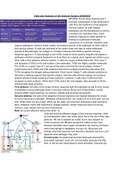Lecture notes
BS5100 Immunology Notes for the Immune System
- Institution
- University Of East London (UEL)
The anatomy and use of the immune system are discussed in detail, including the variety of cells involved. The cytokines produced by various cells are also described. The B cell and T cell response is looked over, and the development of these cells is described.
[Show more]



